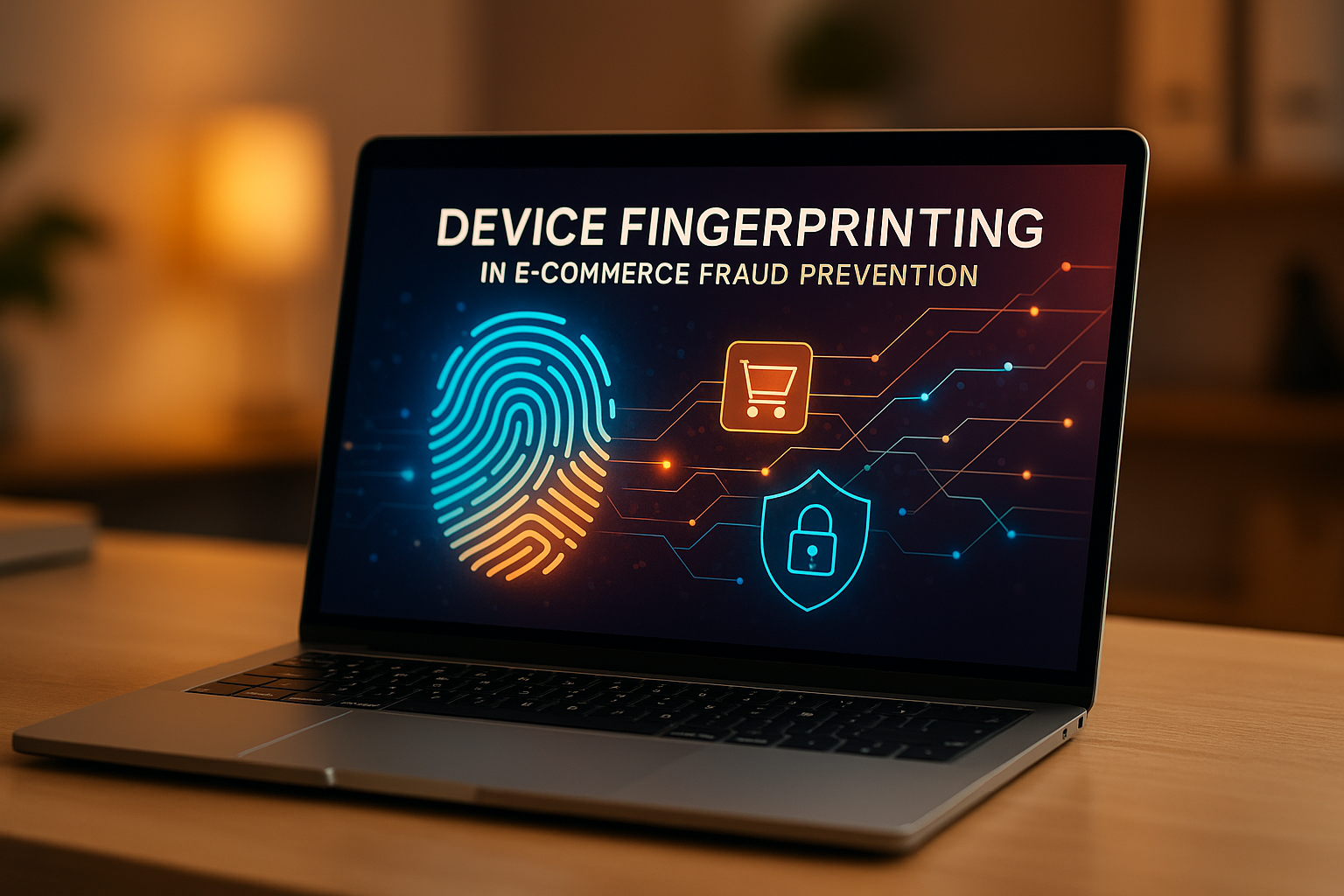E-commerce fraud is expensive, growing, and complex – but device fingerprinting offers a powerful way to fight back. By identifying devices based on their unique configurations and behaviors, merchants can detect fraud more accurately and reduce risks like chargebacks and account takeovers.
Key Highlights:
- Fraud Detection Accuracy: Device fingerprinting identifies returning users with 99.5% accuracy and is 50x more effective than cookies in spotting fake accounts.
- Chargeback Reduction: Links transactions to specific devices, providing evidence to dispute false claims.
- Account Takeover Prevention: Flags unfamiliar devices and triggers additional security checks.
- Behavioral Analysis: Tracks user patterns like mouse movements and typing rhythms to detect suspicious activity.
- Cost Savings: Merchants lose $3.75 for every $1 of fraud, and this technology helps cut those losses.
Why It Matters:
Fraud costs U.S. merchants billions annually, with chargebacks and account takeovers causing the most damage. Device fingerprinting works quietly in the background, identifying threats while ensuring a smooth experience for legitimate customers.
This article explains how device fingerprinting works, its benefits, and how merchants can integrate it into their payment systems while staying compliant with privacy laws. Learn how this tool is reshaping fraud prevention strategies.
Common E-commerce Fraud Challenges
E-commerce fraud has reached alarming levels, with global losses climbing to $48 billion in 2023 alone. The United States played a significant role in this trend, accounting for 42% of fraudulent activity and projected to contribute 41% of an estimated $397 billion in global e-commerce fraud losses. For every dollar lost to fraud, merchants incur an additional $3.75 in related costs. This staggering impact highlights the urgent need for effective fraud prevention strategies, such as device fingerprinting, which will be discussed later.
Chargebacks and Payment Fraud
Chargebacks are among the most expensive challenges for U.S. merchants. These arise when customers dispute transactions with their banks, often due to unauthorized use of payment information or what’s known as "friendly fraud." Each chargeback can cost merchants anywhere from $20 to $100 in fees, and when factoring in related expenses, the total cost can be 1.5 to 2.5 times the disputed amount [9][10].
Friendly fraud is particularly troublesome, as it involves legitimate purchases later being contested as unauthorized. Alarmingly, up to 60% of all chargebacks may fall into this category. Adding to the complexity is the rise of card-not-present (CNP) fraud, which is expected to account for 74% of all card payment fraud losses in 2024, exceeding $10 billion. Online transactions are a prime target for fraudsters because they provide more anonymity compared to in-person transactions.
Merchants face additional risks when chargeback rates climb. Payment processors may respond by increasing fees, requiring security reserves, or even terminating merchant accounts. This forces businesses to walk a fine line between implementing strong fraud prevention measures and ensuring a seamless customer experience.
Account Takeovers
While chargebacks directly drain revenue, account takeovers (ATOs) can severely damage customer trust and long-term profitability. These attacks have become more sophisticated and widespread, with nearly 29% of U.S. adults reportedly falling victim to them. Between 2017 and 2020, U.S. merchants saw a staggering 500% increase in ATO-related losses, reaching $25.6 billion. By 2028, these losses are expected to hit $91 billion. The problem continues to grow, with 24% more ATO attacks recorded in 2024 compared to the previous year.
Account takeovers often involve fraudsters exploiting stolen credentials, credential stuffing, or phishing schemes to gain unauthorized access to customer accounts. A significant portion of these attacks – 70% – involve reused passwords, and 53% are tied to social media platforms, showcasing the evolving tactics of cybercriminals.
"Trust is difficult to build and easy to break. Even a single account takeover attack can destroy the confidence customers have in a merchant."
– Mark Watson
Financial and Business Impacts
The ripple effects of e-commerce fraud extend far beyond immediate financial losses. In 2023 alone, merchants lost $38 billion to account takeover attacks, while global fraud-related costs reached a staggering $5.13 trillion annually. These figures reflect not only lost revenue but also the significant resources required for fraud detection, investigation, and resolution.
False positives in fraud detection also present a major challenge, costing businesses an average of 3% of their annual revenue [12]. When legitimate transactions are mistakenly flagged or blocked, frustrated customers may turn to competitors, damaging long-term relationships and brand loyalty.
A 2024 PwC study revealed that over 60% of organizations experienced fraud-related financial losses, with nearly 30% reporting losses exceeding $1 million. Disputing chargebacks adds another layer of complexity, requiring time-intensive efforts to gather documentation and verify transaction details. High-risk merchants face even greater obstacles, as payment processors often impose stricter requirements, higher fees, or additional security measures. This creates a vicious cycle where increased fraud exposure leads to higher operational costs and reduced profitability.
Tackling these challenges requires advanced tools and strategies, such as device fingerprinting, which will be explored in the next sections.
How Device Fingerprinting Works
Device fingerprinting gathers unique characteristics from a device to create a persistent digital identity. This digital fingerprint stays consistent across multiple sessions, making it difficult for fraudsters to hide their tracks, even if they clear cookies or use private browsing modes.
Collecting Device Attributes
The process involves collecting a wide range of device-specific details to generate a unique identifier. For instance, it captures browser configurations like the user-agent string, browser version, and installed plugins. It also records hardware specifications, such as screen resolution, graphics card details, and available RAM.
Network data is another key element. The system logs IP addresses and geolocation to track the device’s origin and connection patterns. Additionally, it gathers operating system details, including version numbers and platform information, while monitoring behavioral traits like mouse movements, click patterns, and typing rhythms.
"Device Fingerprinting uniquely identifies devices by analyzing browser and hardware attributes. It collects data like screen resolution, OS, and installed plugins." – FraudNet
Even subtle settings like time zone, language preferences, and device orientation are captured. These combined elements create a detailed profile that’s extremely hard to mimic or fake.
| Data Category | Specific Data Points |
|---|---|
| Browser Information | User-agent string, browser version, installed plugins, HTML5 canvas size, audio processor |
| Operating System | Version, platform |
| Hardware Information | Screen resolution, device orientation, available fonts, graphics card, RAM |
| Network Information | IP address, network details, geolocation |
| Behavioral Analysis | Mouse movements, click patterns, keystroke dynamics |
Creating Device Profiles
Once collected, these attributes are processed by algorithms to form a unique device fingerprint. This fingerprint acts as a stable identifier across sessions, allowing systems to recognize returning devices without relying on cookies, which users can easily delete.
The system generates hashes – such as device hashes, browser hashes, and cookie hashes – to identify potential threats. Unlike cookies, which are stored locally, device fingerprints are stored in server-side databases. This server-side storage ensures the fingerprint remains accessible and robust, as hardware and software details typically don’t change, even if a fraudster switches browsers or clears browsing data. Beyond static profiles, behavioral analysis adds another layer of precision to risk assessment.
Behavioral Analysis and Risk Scoring
After establishing a static profile, the system evaluates user behavior to detect signs of fraud. By analyzing typing patterns, navigation habits, and interaction speeds, it creates behavioral signatures that enhance fraud detection.
The system also flags technical anomalies, such as attempts to spoof browsers, the use of anti-fingerprinting tools, unusual screen resolutions, or evidence of automation tools. Virtual machine environments, often used by fraudsters to mask their systems, are similarly identified.
Risk scoring assigns a risk level based on various factors, including behavioral patterns, device attributes, geolocation, and historical transaction data. Machine learning algorithms refine this process, adapting to emerging behaviors. Organizations using these techniques have reported a 50–90% boost in detection rates, while behavioral analysis has been shown to reduce false positives by 30%.
Real-world examples highlight the effectiveness of this approach. PayPal, for instance, uses behavioral analysis to monitor device data, email activity, identity scores, session details, and account enrollment. This helps flag issues like mismatched addresses or unusually large orders. Similarly, Transparent Labs employs advanced analytics to catch unusual login times, browsing patterns, and suspicious purchases, effectively curbing credit card fraud.
When high-risk behavior is identified, the system can trigger adaptive security measures in real time. These might include additional authentication steps, temporary account locks, or transaction flags, enabling swift action to prevent fraudulent activities. Together, these methods provide a strong, real-time defense against fraud.
sbb-itb-8c45743
Device Fingerprinting for E-commerce Fraud Prevention
Building on earlier technical insights, this section delves into how device fingerprinting directly combats e-commerce fraud. By creating persistent digital identities, this technology works quietly in the background, identifying and neutralizing threats before they can disrupt transactions.
Detecting and Blocking Suspicious Devices
Device fingerprinting analyzes unique attributes of a device to create a lasting digital record. This record allows systems to automatically block devices with a history of fraudulent activity. For example, it can effectively stop card testing attacks, where fraudsters use stolen credit card numbers to make small purchases to verify active cards. It’s also a powerful tool against coupon abuse, identifying users who attempt to exploit promotions by creating multiple accounts.
One case study highlighted its effectiveness: a payment provider reduced fraudulent transactions by an impressive 90% after implementing device fingerprinting. Additionally, the technology flags suspicious activity, such as the use of virtual machines or proxy servers, enabling systems to block transactions or escalate them for manual review.
Preventing Account Takeovers
Account takeover fraud is a growing concern, with losses reaching $11.4 billion and incidents increasing by 90% in 2021. Device fingerprinting strengthens account security by distinguishing between familiar and unfamiliar devices. When a user logs in from their usual device, the system recognizes it as trusted and grants access. However, if an unfamiliar device with unusual characteristics attempts access, the system triggers extra security measures like step-up authentication or temporary account holds.
For example, one implementation achieved 99.5% accuracy in analyzing device data, ensuring security while minimizing disruptions for legitimate users. This layered approach significantly bolsters overall fraud prevention strategies.
Reducing Chargebacks and Payment Fraud
Chargebacks can be costly, both in fees and administrative overhead. Device fingerprinting links transactions to specific device profiles, providing clear evidence in disputes. When a customer challenges a charge, merchants can use this data to prove the transaction originated from a device previously associated with legitimate purchases. This method is also effective against friendly fraud, where customers claim they didn’t authorize a legitimate transaction.
In 2022, 62% of financial institutions reported increases in both the frequency and cost of fraudulent transactions. For high-risk merchants, device fingerprinting is invaluable – it helps identify repeat offenders across multiple accounts and payment processors, making it increasingly difficult for fraudsters to operate undetected.
Implementing Device Fingerprinting in Payment Systems
For merchants in the United States, integrating device fingerprinting into payment systems requires careful planning to meet both technical and regulatory demands. Below, we’ll explore key steps and considerations to ensure a smooth implementation.
Integration with Payment Gateways
To make device fingerprinting effective, it’s essential to integrate it directly with your payment gateway. This involves embedding scripts on checkout pages to collect device data seamlessly during transactions. The collected data is then processed into a unique identifier, or "fingerprint", which helps detect returning users or flag suspicious activity in real time.
Your payment gateway must support the transmission and analysis of this fingerprint data without causing delays. The system should be capable of comparing the fingerprint against existing records during the transaction, enabling quick identification of potential fraud while maintaining a smooth customer experience.
Compliance and Privacy Considerations
Privacy laws in the U.S., such as the CCPA/CPRA, play a crucial role in shaping how merchants deploy device fingerprinting. For instance, businesses must allow California residents to opt out of data collection and sharing. While these regulations don’t outright ban fingerprinting, they emphasize transparency and user rights.
To stay compliant, merchants should update their privacy policies to explain how device fingerprinting works, what data is collected, and how long it’s retained. Offering customers the option to disable fingerprinting can also help balance privacy concerns with fraud prevention efforts. Clear communication about these practices builds trust and ensures adherence to regulatory standards.
Fraud Prevention for High-Risk Merchants
High-risk merchants – those operating in industries like gaming, adult entertainment, or CBD – face unique challenges that make device fingerprinting particularly valuable. For these businesses, fingerprinting can be a cornerstone of a dynamic fraud prevention strategy. By analyzing device characteristics, transaction history, and behavioral patterns, these systems can adjust risk thresholds accordingly. Devices with clean records can proceed without issue, while suspicious ones may trigger additional verification steps.
Secured Payments addresses these needs through its High-Risk Plan, which combines device fingerprinting with other fraud prevention tools like address verification, 3D Secure authentication, and behavioral analysis. This layered approach ensures that even if one method is bypassed, others remain effective at identifying and stopping fraudulent transactions.
Real-time risk scoring further enhances this system, evaluating device reputation alongside transaction details. This allows merchants to approve legitimate customers quickly while flagging suspicious activity for further review, creating a balance between security and smooth operations for high-risk businesses.
Conclusion
After diving into the details, it’s clear that device fingerprinting is a game-changer for tackling e-commerce fraud. For U.S. merchants, this technology is especially vital as they face the rising tide of online fraud. With global e-commerce fraud losses projected to surpass $343 billion between 2022 and 2027, and the United States leading as the most fraud-prone country – where 34% of consumers report being victims – the stakes couldn’t be higher.
Key Takeaways
Device fingerprinting offers unmatched accuracy and reliability in fraud prevention. It boasts up to 50 times better fake account detection compared to cookies and achieves 99.5% accuracy in identifying returning users. This level of precision is a critical tool to combat account takeovers, which surged by 90% in 2021, causing an estimated $11.4 billion in losses.
Beyond account takeovers, device fingerprinting addresses a range of fraud scenarios. It detects unfamiliar devices to prevent unauthorized logins, identifies card testing patterns to block fraudulent transactions, and flags multi-account abuse to stop bonus exploitation. For merchants struggling with chargebacks and friendly fraud, the technology’s ability to analyze historical data helps spot suspicious patterns and limit false claims.
Using a Layered Approach
While device fingerprinting is highly effective, it works best as part of a broader fraud prevention strategy. In 2022, 62% of financial institutions reported rising fraud volumes and costs, highlighting the need for multi-layered defenses. Pairing device fingerprinting with tools like behavioral analytics, multi-factor authentication, and transaction monitoring creates multiple barriers that fraudsters must overcome. Adding elements like behavioral biometrics, threat detection, and location data further strengthens these defenses.
How Secured Payments Can Help

As payment fraud continues to affect 80% of organizations in 2023, Secured Payments offers tailored solutions to meet these challenges head-on. Our High-Risk Plan integrates device fingerprinting with tools like address verification, 3D Secure, and behavioral analysis to safeguard transactions effectively.
We aim to protect customer data while ensuring smooth, legitimate transactions. By balancing fraud prevention with a seamless customer experience, our solutions flag suspicious activity without disrupting genuine purchases. For high-risk merchants, we adapt device fingerprinting strategies to evolving fraud tactics, all while staying compliant with U.S. privacy regulations. With flexible pricing across our Basic Merchant Plan, E-Commerce Plan, and High-Risk Plan, Secured Payments delivers solutions tailored to your specific fraud prevention needs and risk profile.
FAQs
How is device fingerprinting more effective than cookie-based tracking for preventing e-commerce fraud?
Device fingerprinting outshines cookie-based tracking by examining various device attributes – like browser type, installed plugins, and screen resolution – to generate a unique and persistent identifier. While cookies can be deleted or blocked by users, device fingerprinting stands firm, maintaining its reliability across sessions even when cookies are disabled.
This method plays a crucial role in fighting e-commerce fraud, such as chargebacks and account takeovers. By consistently identifying devices and spotting unusual activity, it provides an extra layer of security for online businesses.
What privacy concerns arise with device fingerprinting in e-commerce fraud prevention, and how can businesses comply with laws like CCPA and CPRA?
Device fingerprinting can lead to privacy concerns because it gathers unique details about a user’s device. This data, which might include device identifiers, browsing habits, and other sensitive information, could be classified as personal data under laws like the California Consumer Privacy Act (CCPA) and the California Privacy Rights Act (CPRA).
To stay compliant, businesses should take the following steps:
- Inform users about what data is being collected and why.
- Get consent when necessary, especially from users in California.
- Offer opt-out options so users can control how their personal data is used or shared.
Beyond these measures, maintaining transparency in privacy practices and performing regular risk assessments can help meet legal standards while building trust with users.
How can businesses integrate device fingerprinting into their payment systems without negatively impacting the customer experience?
Device fingerprinting can be seamlessly incorporated into payment systems by embedding small pieces of code, like JavaScript snippets or tracking pixels, directly into payment pages. This approach enables secure data collection to happen quietly in the background, without disrupting the checkout process or affecting the user experience.
This technology works alongside tools such as behavioral analytics and multi-factor authentication to recognize returning customers and flag potential fraud across different devices. The result? A strong layer of fraud prevention that doesn’t compromise the smoothness of the checkout process, keeping transactions secure and customers happy.




